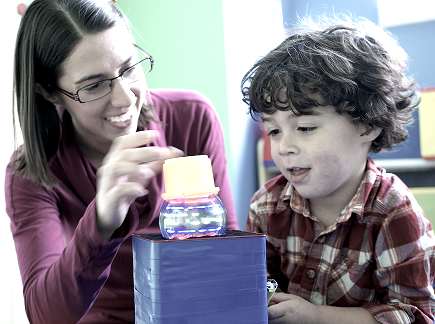
Kim Scott, currently a research scientist in the Early Childhood Cognition Lab at MIT, developed and currently runs the online branch of the lab, Lookit.
On the Lookit website, families can contribute from home to research about how children learn. Parents and children complete short activities right in the web browser as webcam video of the child’s responses is sent back to the lab for later analysis. Among other applications, Kim is especially interested in seeing this platform used to characterize individual differences in development and to refine experimental methods used in developmental psychology.
What initially brought you to study cognitive development?
I’ve always been fascinated by the puzzle of how our minds make sense of the world – and where our corresponding subjective experiences come from. To understand a system, scientists and historians both often look at how it developed – whether that means investigating how clouds of matter condense into stars or tracing the roots of a political movement back through history. Studying development lets us look at some of the fundamental building blocks of human cognition – the abilities and assumptions that we use to construct our understanding of the world as we gather experience.
What has been the biggest change in developmental research since you began investigating early childhood cognition?
I’ve been lucky to witness the beginning of a tremendous change in our understanding of what it means to do truly cumulative science—that others can build on. We’re realizing that our human tendencies as scientists – like being excited about surprising results – affect the reproducibility of published research. Just in the past five years there’s been a huge movement towards practices like preregistering experimental designs – recording what data you will collect, and what statistical tests you’ll run to evaluate the outcome, before doing the experiment. And we’re realizing that some of the most exciting questions in the field are more “open” than we once thought!
How can we help make learning more effective in early childhood education to produce lifelong outcomes?
There’s a lot we don’t know about how to support learning in early childhood! While there’s great evidence for the value of open-ended play rather than academic structure early on, particular interventions are hard to study, especially when we want to know about long-term outcomes. I think we really need to make this work more accessible, including by providing tools for conducting rigorous research to a broader group of people – including more educators with practical experience. I’m hopeful about the potential for online research to accelerate work like this – where we want to study either a diverse group of kids from all over the country or a group of kids with a particular developmental disorder, and understand how various aspects of their educational experience affect learning over multiple years.
What type of research is ongoing currently on Lookit?
Right now, we’re working on scaling up the platform so that we can allow researchers anywhere to use Lookit to run their own studies. There are a couple of studies available that kids can already participate in!
One is about how seven-month-olds perceive shapes - it’s a collaboration with Molly Dillon at NYU and Liz Spelke at Harvard. We show babies two streams of triangles. On one side of the screen triangles alternate between big and small, but they’re the same shape. On the other side, we’re also switching between a short fat triangle and a long skinny triangle. Just from the webcam video of the baby watching this display, we can easily tell which direction the baby is looking, and use that to see if babies show a preference for the shape-changing stream.
The other study is about babies’ intuitive understanding of physics. It’s also a preferential looking study, where we show a bunch of pairs of videos and measure looking to each side of the screen. On one side, babies see something pretty normal happen, like a ball rolling down a ramp. On the other side, they see a less physically plausible version, like a ball rolling up the ramp instead. I’m actually especially excited about being able to better understand what preferential looking means with this study, because we’re going to characterize the sorts of variation we see both between kids and within kids. We’re having families return and complete up to 12 sessions, so we can both get better estimates of their preferences on the physics judgments, but also see how consistent those preferences are over time, and how much some basic measures of “looking style” change when kids are tired, say.
What is your favorite thing about working and studying at MIT?
I love the enthusiasm here for ideas – both the excitement about new ideas and the willingness to reconsider and think deeply about old ones! My favorite part of my job is working with students and getting to introduce folks to research.